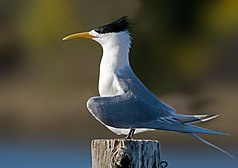Claremont Isles National Park
| Claremont Isles National Park | ||
|---|---|---|
| Common Tern ( Thalasseus bergii ) | ||
|
|
||
| Location: | Queensland , Australia | |
| Specialty: | Coral islands | |
| Next city: | 270 km from Cooktown | |
| Surface: | 63 ha | |
| Founding: | 1989 | |
| Hawksbill sea turtle ( Eretmochelys imbricata ) | ||
The Claremont Isles National Park (English Claremont Isles National Park ) is a 63 hectare national park in Queensland , Australia . It is located within the Great Barrier Reef and is therefore part of the UNESCO World Heritage Site .
location
The national park is located 385 kilometers northwest of Cairns on the east coast of the Cape York Peninsula in the Coral Sea . The islands are located off Point Stewart north of Princess Charlotte Bay , 55 kilometers east of Coen and 270 kilometers northwest of Cooktown .
In the immediate vicinity are the Marpa , Sandbanks and Flinders Group national parks in the Coral Sea , and KULLA (McIlwraith Range) and Lama Lama on the mainland .
National nature
The archipelago consists of a total of three islands, Fife Island , Pelican Island and Burkitt Island .
fauna
The islands are an important resting and nesting place for birds, so visitors should avoid going ashore, camping is prohibited. Different species of terns live on all islands . The common tern ( Thalasseus bergii ) is particularly common, but the little tern ( Sterna albifrons ), which is threatened with extinction, is also native to the islands.
Burkitt Island is home to a large number of two-colored fruit pigeons ( Ducula bicolor ) and the extensive sandy areas and lagoons are a habitat for migratory birds such as the reef triel ( Esacus giganteus ). Pelican Island is named after a colony of African pelicans that breed here regularly; Wedge-tailed Shearwater ( Puffinus pacificus ) live on Fife Island .
The reefs surrounding the islands and extensive seagrass meadows are an important habitat for dolphins , dugongs and sea turtles . A small colony of Hawksbill sea turtles ( Eretmochelys imbricata ) breeds on Pelican Island .
Web links
- Official site of the park (English)
Individual evidence
- ↑ Australian Government - CAPAD 2010 ( MS Excel ; 170 kB), DSEWPaC , accessed on October 7, 2012 (English)
- ↑ Australian Government - CAPAD 1997 ( MS Excel ; 93 kB), DSEWPaC , accessed on October 7, 2012 (English)
- ↑ a b c d Official Park Website - About , Queensland Parks and Wildlife Service , accessed October 7, 2012
- ↑ a b Species List , Queensland Parks and Wildlife Service , accessed October 7, 2012


